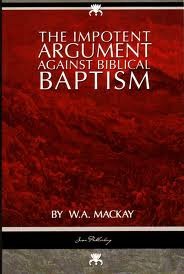| I wrote an article several months ago about infant baptism. Having just had our church's first infant baptism, and understanding that many who know us have never thought much about infant baptism (also called paedobaptism), I decided to share some of what I found beautiful about it as opposed to the baptism only of new converts (known as believer's baptism or credobaptism). I did not at all intend for my former article to be an exhaustive defense of infant baptism, but rather an expression of ideas to get the wheels turning for people - to be exposed to what may be a new idea for some, and for others, to help them think through what they may have just assumed is the case due to their upbringing. But while that post served its purpose, I have felt the need to lay out a more exhaustive case for infant baptism, particularly as we look to baptize our son here in the near future. |
Before I get into the issue proper, I do want to make a few things clear. First and foremost the issue of how we baptize does not determine one's Christianity. Just as those who take communion sitting down, standing up, dipping the bread, using grape juice, using wine, using crackers, eating separately, or eating simultaneously are all Christians if they have made Christ their lord, so those who baptize by sprinkling or those who baptize by immersion are Christians if they have made Christ their lord. This discussion should be a cordial, in-house discussion among Christians. While I disagree with believer's baptism and immersion, I know, love, and respect many who hold these views that are contrary to mine. I understand their view and I know they are trying to do their best to follow what they believe to be the biblical model of baptism. I understand that they have reasons for believing as they do, even if I disagree with their conclusion or believe that their case is outweighed by the case that I am about to make. I hope the same grace and generosity is afforded to me even if you end up disagreeing with me.
With that being said, some may think that this issue is then not that important. If it does not weigh on our eternal state, then why take the time to discuss such a topic? I think the simple answer is that God has commanded baptism. Baptism has been an integral part of the church's history and it is something that God himself has instituted. That means he intends to say something very important through this symbol. While we don't "need" the correct form of baptism to enjoy God forever, we may miss out on some beautiful theological truths that come in understanding what baptism is intended to convey. God wants to bless us and we should want to receive God's blessings - baptism being one of those blessings.
Scope:
It is important to note that there is no place in scripture that directly details how a person is to be baptized in the New Testament. Since no direct "how" is given, it is our job to look at all of the cumulative evidence and build a case from the context of all scripture. It is very important to keep these notions of "cumulative" and "contextual" in mind, as far too often we use one passage - or even worse, one snippet of a passage - as evidence because we believe it to be clear, when in reality we are using circular reasoning and presupposing definitions based on our bias. We need to weigh the whole case and we need to do our best to understand the issue from the context of the early Christians and all of scripture, not from the notions ingrained in us from our own cultural context and upbringing.
Since the approach we use must be to build a cumulative case, it is very important to hear the evidence out until the end. Often times there are aspects of a cumulative case that don't tip the scales for a particular side in and of themselves, but taken in light of all the evidence they can be extremely weighty. Please hear the whole case out until the end. Since cumulative cases often entail a plethora of details and information to consider, I am going to do my best to keep the evidence short and sweet, with the briefest explanations I can muster, and with scriptural references you can look into further to cross-check. I will also provide significant resources for you with which you can follow-up should you desire to research the topic in more depth. Or you can just contact me and I'll talk your ear off.
Finally, though the main issue in view is infant baptism, you will find that it is helpful to understand the appropriate mode of baptism as well. The two often go hand in hand. If immersion only represents a burial and resurrection with Christ after a profession of faith, then obviously infants don't fit the requirement to receive such a symbolic gesture. If the notion of moving water, usually conveyed today by pouring or sprinkling, represents being consecrated into God's covenant community and a statement as to what God can do, then infants can, and likely should be included in such a symbolic gesture. The mode and the object of baptism tend to go together. For this reason you will find that many of the arguments below deal with the mode (sprinkling/pouring vs. immersion) rather than the object of baptism (new believers and infants vs. only new believers).
So, without further adieu, here is the cumulative case for infant baptism.
The Old Covenant and its Connection to the New: Most who hold to the practice of infant baptism view the New Testament to be more of a continuation and fulfillment of the Old Testament rather than a largely new dispensation that is more disconnected than not from the previous dispensations. It is important, then, to begin by discussing the overarching foundation for infant baptism, which is God's continued work through the covenant he has thread throughout all of biblical history unto now.
- Genesis 17 gives a clear command for Abraham and his descendants, the people of God's covenant, to be circumcised. They are to do this unto all generations. Though there are a number of promises God gives in this covenant, the core of the covenant promise here is found in verse 7, where God says, "And I will establish my covenant between me and you and your offspring after you throughout their generations for an everlasting covenant, to be God to you and to your offspring after you." God promises to be a God of his covenant people, which includes even the youngest of children.
- The sign of circumcision that God gave to Abraham was one that could only be applied to males, but represented the whole household. Though a woman couldn't be circumcised, were she to be married to a man who was circumcised or born to a father who was circumcised, she was considered a part of the people (e.g. Ruth).
- There is no direct command given to stop the marking of Abraham's descendants, God's covenant people. We, the Christian church, are Abraham's descendants and God's covenant people. Galatians 3:7-9, 29 and Romans 2:28 . Romans 11:11 ff. is also a great passage to see how we we are Abraham's descendants and part of Abraham's family, the true Israel. It seems, then, that if the covenant promise applies to us, as we are Abraham's descendants whom God says should be marked throughout generations as an everlasting covenant, then the sign and command God gave to mark his people still applies.
- While many OT laws have been done away with, this is only true of laws that have found their completion in that to which they foreshadowed. Whereas the moral laws (e.g. love your neighbor, do not murder, etc) never go away since those are tied to the nature of God and are an eternal obligation for us, other laws, the ceremonial laws, were instituted by God to foreshadow a future truth or accomplish a particular purpose in time. I believe Jesus would agree with this notion, as in Matthew 5:17-20, he declares that he did not come to abolish the law, but rather to fulfill. So while Christ did not come to give us freedom from our moral obligations and do away with the OT, he did come to be the true sacrifice that freed us from the ceremonial obligations we were required to fulfill due to our guilt, and he came to bring to fullness the covenant God made with his people so long ago. This is why we no longer sacrifice animals for our sins. That was accomplished in Christ. Hebrews is a great book to read on this topic for further reference.
- Circumcision, however, was commanded of God's community prior to the clear Mosaic Law and institution of the ceremonial law. It's the first command God gives to his people upon establishing them, and this command is not a foreshadowing of any idea that was completed. As long as new individuals are brought into the community through proselytization or through birth, there will be a need to mark God's people. This command is meant to incorporate new members into the visible community of God's people, whether proselyte or newborn. We continue to have new members added to God's visible community today. This command that was given to Abraham so long ago has not found fulfillment and is therefore still applicable.
- Since we have a command given to God's people that has not been nullified through direct command or the completion of Christ's work, the burden of proof lies on those who are against infant baptism to explain how God's command to mark a segment of his visible community who have always been included, is now nullified today - or how that command can be seriously hogtied and diminished by restricting individuals who were to be included in God's original directive, namely children.
- Those who advocate for infant baptism often point to baptism as a continuation of circumcision, and therefore consider that baptism is the adherence to God's command to circumcise, or mark his people. Circumcision was instituted to mark those under God's covenant. Baptism was instituted to mark those under God's covenant. Circumcision doesn't save. Baptism doesn't save. Circumcision represented the cutting away of wickedness (circumcision of the heart). Baptism represents the regeneration of the heart and the washing away of wickedness by the blood of Christ, or a consecration unto God. While the bloody rite of circumcision is not continued in the same form, it is continued in the same vein. As Christ accomplished his work on the cross and prepared a place for us by interceding on our behalf for the Holy Spirit to come upon us, we now have a marking not of our own blood and our own flesh, but of Christ's blood coming upon us through the Spirit's work. The mark of baptism represents the same thing, but is applied via a different mode because God has now fulfilled his promise to send his Spirit to circumcise not our flesh, but our hearts. Therefore, our own blood need not be shed, but rather the blood of Christ must come upon us just as all people and instruments of old were sprinkled with the blood of purification and consecration. As we explore some of the scriptures in the next section, you will see how baptism and circumcision are sometimes linked together by the biblical writers.
- Romans 4 is a nice passage that helps us to see how the application of baptism can make sense with infants. While I have already argued that baptism is a continuation of the command to consecrate a people unto God, it is still hard for many immersionists to imagine baptizing infants, as they associate baptism with a professed personal faith in God. But Romans 4:11-12 helps us to see how God would likely view such an event if baptism were intended for infants of believers. In Romans 4 Paul writes, "[Abraham] received the sign of circumcision as a seal of the righteousness that he had by faith while he was still uncircumcised. The purpose was to make him the father of all who believe without being circumcised, so that righteousness would be counted to them as well, and to make him the father of the circumcised who are not merely circumcised but who also walk in the footsteps of the faith that our father Abraham had before he was circumcised." We see that circumcision was a sign that God gave to all of Abraham's descendants, not because they were a particular nationality, but because their father had a particular faith. The faith of Abraham's descendants was looked forward to through the rite of circumcision. Notice how the Bible says that Abraham is the father of those "who are not merely circumcised." Circumcision was the sign of the covenant, not the guarantor of faith, as we also see that it was not this circumcision that saved anyone, but rather having the same faith as Abraham. Despite the fact that circumcision represents a promise only to believers, and not all of Abraham's descendants believed, yet all Abraham's descendants were still marked with circumcision. The sign of belief preceded belief and was administered prior to belief for most (only proselytes were circumcised after belief). The NT is clear that if we have faith in Christ's work, we are descendants of Abraham. Despite the requirement of faith, God still instituted that a visible sign be issued for the visible community who came together to worship him, which in the context of scripture, seems to include our children as well.
- When new converts in the NT, especially Jewish converts, heard that there was a mark of baptism that brought them into this new religious community, all of their history and culture would have screamed to them that this mark was for their children as well. It only makes sense that if God's directive had changed to exclude the children of his people, the Apostles would have made the new parameters clear. Yet they use the language of family. Acts 2:39 shows this very clearly when it is said that the new believers should be baptized, as the promise of God is for them and their children. It is for everyone who enters the visible community. While credobaptists often argue that they would require a direct command from God to baptize their children, I wonder why their stipulation isn't rather that they require a direct command from God to stop incorporating their children into the visible community as had been done for millennia prior to the NT, and for the first 1,500 years of church history following the institution of baptism. The majority of Christians (Catholics, Orthodox, and many Reformed Protestants), for the majority of church history, have baptized infants.
For a great synopsis of the connection between circumcision and baptism, check out the short video below.
NEXT: Part 2: Sprinkling and Consecration





 RSS Feed
RSS Feed